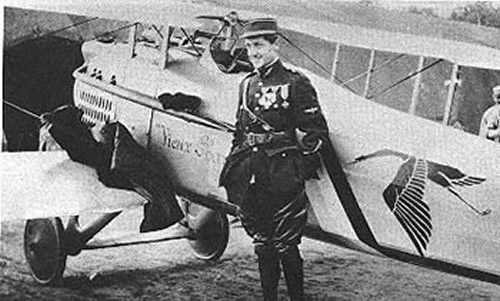
A word of history about Guynemer and his plane Morane Saulnier L:
The French air fleet counted only 138 aircraft in August 1914; in November 1918 there were already 11,900 or an increase of almost 900%. During the First World War, France produced 52,000 aircraft and 92,000 aircraft engines. This is the most of all belligerent countries. Germany can only compare 38,000 aircraft and 41,000 aircraft engines. In the run up to the war, France was already striving for a technological superiority that had to compensate for its demographic disadvantage vis-à-vis Germany. In 1914 Germany had 76 million inhabitants, France only 41 million.
Morane Saulnier L:
The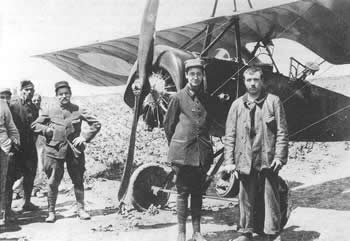 aircraft Morane Saulnier L is one of the four that the French army chooses in November 1914. Because the wing is above the hull, the soldiers turn it into "Morane Parasol". That high wing makes it suitable as an observation device and because it can land on small fields, it is also used for special assignments. Guynemer has also flown special missions, such as the setting up of a saboteur in enemy territory or the bombing of the station in Chauny in October 1915.
aircraft Morane Saulnier L is one of the four that the French army chooses in November 1914. Because the wing is above the hull, the soldiers turn it into "Morane Parasol". That high wing makes it suitable as an observation device and because it can land on small fields, it is also used for special assignments. Guynemer has also flown special missions, such as the setting up of a saboteur in enemy territory or the bombing of the station in Chauny in October 1915.
On July 19, 1915, Guynemer achieved his first victory with the MS 376. As a pilot, he maneuvers the aircraft in a position where his mechanic Charles Guerder can shoot an Aviatik two-seater at the Carrière l'Evèque farm in the municipality of Septmont, south of Soissons. .
<= In the photo (SHAA) taken afterwards, Guerder holds his helmet, which was pierced by a German bullet. One centimeter lower and it had already passed for him and perhaps also for a defenseless Guynemer.
It is this unit that was reconstructed from 2006 to 2009 at the VTI of Ypres around an authentic 80 hp Rhone engine.
Nieuport:
From October 1915 to August 1916, Guynemer flew with Nieuport. With various types of that plane he gained thirteenth recognized victories (two to 14).
The first Nieuport he received, a Nieuport 10, was named "Vieux Charles", a name given by the previous owner Charles Bonnard. Because Guynemer immediately had a success with it, he retained that name for his next devices. This name will adorn five different types of Nieuport. Afterwards there will be four Spad aircraft that will be painted with that name.
During the Battle of Verdun, which began on February 21, 1916, the French pilots initially could not compete with the German "Fokker Eindecker" with their synchronized machine guns which also operated in battle groups (Jagdstaffeln). On March 13, 1916, it was decided to group eight escadrilles groupers in a "Groupement de Chasse" under the command of Commander de Rose. Thus the French can gradually regain the air superiority over Verdun.
The "Groupement de Chasse" of Verdun was another provisory unit, which was definitively divided into four "Groupes de Combat (GC)" at the Somme: 11, 12, 13, and 14.
GC 12 has four escadrilles that all carry the stork ("la cigogne") as an emblem: N3, N26, N73 and N103. At the escadrille N3 this was since July 1916. The others followed in April 1917.

- Escadrille 3 has a stork in flight with folded wings. The most famous pilots are: Guynemer (53 victories), Dorme (23) and Heurtaux (21).
- Escadrille 26 has a stork in a stretched flight. Roland Garros, the inventor of the deflection plates on the screws, flew at this unit.
- Escadrille 73 has a twisted stork. A well-known pilot was Deullin (20 overw.)
- Finally, Escadrille 103 has a stork with folded wings. The most famous pilot was the topaz Fonck (with 75 victories).
(Drawing from Pierre Roehr, La véritable history of "Vieux Charles et de la Cigogne"
in Icare, No. 122, 1987, p. 90.)
The stork was chosen by the commander of GC 12, captain Brocard, but that bird of course also referred to Alsace, where the migratory bird makes its nest and to its retreat, which France fought for.
Escadrille 3 existed from before the war and its name changed according to the aircraft she flew with. That's how escadrille 3 was called successively: Bl.3 (Blériot X, since 12 July 1912), MS 3 (Morane Saulnier, March 1915), N 3 (Nieuport, January 1916) and finally Spa 3 (Spad, January 1917). Within escadrille 3 Guynemer got the number 2 on the basis of seniority.
Escadrille 3 was the most successful of all French escadrilles. She earned 175 recognized and 160 "probable" victories. Of the approximately 80 pilots, twelve brought it to bait, but a quarter also did not make it to the end of the war.
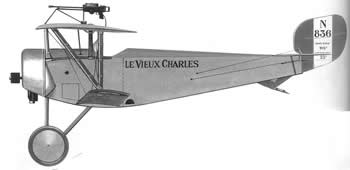 Characteristic of the Nieuport is its shorter lower wing. This gives this device greater maneuverability. Initially, Nieuport flew with an 80 hp rotary engine (just like the Morane Saulnier).
Characteristic of the Nieuport is its shorter lower wing. This gives this device greater maneuverability. Initially, Nieuport flew with an 80 hp rotary engine (just like the Morane Saulnier).
<= Nieuport 11 (bébé), the second "Vieux Charles", March 1916.
Later types had a 110 hp engine. In one of his first landings with that heavier engine of the Nieuport XI (also called "bébé"), Guynemer parked his aircraft vertically. He still had to get used to the larger centrifugal forces.
From July 1916, the Nieuport was equipped with a synchronized machine gun that could shoot through the propeller field. At that moment a new plane made its appearance, that for the rest of the war the best French hunting gear would remain: the Spad.
Spad
With the Spad, Guynemer achieved the majority of his victories. First 34 with the Spad VII. The last months four with the Spad XII - those with the 37mm propeller shaft - and one with the Spad XIII.
Spad VII Spad XIII
Maximum speed 192 km / h 210 km / h
Ceiling 5.300 meters 6900 meters
V-engine (Hispano-Suiza) 180 hp 220 hp
Armament One synchronized Vickers (7,7mm) and sometimes a Lewis on the upper wing Two synchronized Vickers (380 bullets each)
Compared to the Nieuport XI, the Spad is more powerful, agile and firmer. Hispano-Suiza, a Catalan company with a Swiss director, who supplied the water-cooled V-engines for the Spad, was set up with the success of Guynemer to give him one of their cars as a gift. After the war, the firm even takes over the stork as an emblem for its cars.
The cannon of the Spad XII - an idea fix by Guynemer - made the aircraft heavier and therefore less suitable as a fighter plane. In total, only 62 were produced before the armistice. No copy of the Spad XII, which Guynemer was given the nickname "Pétadoux", has been preserved. The Spad that is suspended in the Air and Space Museum of Le Bourget is a Spad VII, where Guynemer has won his most victories.
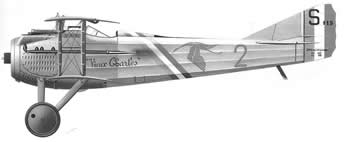
Spad VII, the "Vieux Charles" VII, September 1916. Guynemer's first Spad
The hunting gear was pre-eminently late 1917 and in 1918 the Spad XIII. With that device alone, René Fonck scored 53 victories. As many as Guynemer are total.
Our Replica Morane Saulnier Parasol L:
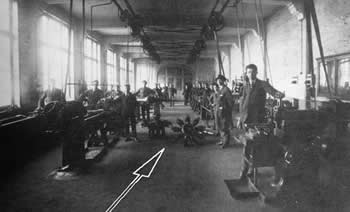 Just back in the history of our school (V.T.I.-Ypres). In the twenties of the last century, just after the First World War, the Flemish technical and vocational schools were given an aircraft engine with spare parts to make drawings and practice maintenance. This type of engine, a rotating nine cylinder of 80 hp, apparently was no longer used. (Photo at the top: The mechanics department in 1927. The engine is centrally located.)
Just back in the history of our school (V.T.I.-Ypres). In the twenties of the last century, just after the First World War, the Flemish technical and vocational schools were given an aircraft engine with spare parts to make drawings and practice maintenance. This type of engine, a rotating nine cylinder of 80 hp, apparently was no longer used. (Photo at the top: The mechanics department in 1927. The engine is centrally located.)
This engine was for years a showpiece on the Open House, when he was set in motion with a deafening noise. After a lot of wandering the engine fortunately came back in VTI hands and a few years ago it was decided to redesign that rare engine. A daring piece that has cost a lot of investigation work.
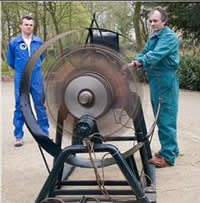
<=Pol Lietaert and JohanVanbeselaere at the Rhône 9C in action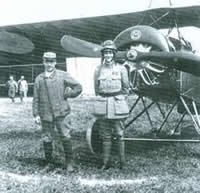
A working motorcycle on a tripod looks nice, but it remains only an engine. What is missing is a matching aircraft. Turns out now that this type of engine was used in the Morane Saulnier L, also called "Parasol" because the wing is mounted above the hull. This was one of the first reconnaissance aircraft of the French army. When the observer took a machine gun with him, it became a fighter plane. The French bait Georges Guynemer achieved his first victory as a pilot of such a plane. His supervisor and mechanic, Charles Guerder, pulled down the German machine. Charles Guerder and Georges Guynemer after their first victory on July 19, 1915. =>
On this type of aircraft, the pilot Roland Garros, who gave his name to the well-known tennis courts in Paris, placed deflections on the screw for the first time, so that he could fire through the helical field with his machine gun. After an emergency landing in occupied West Flanders, the Germans took his aircraft with them and their engineer Anthony Fokker perfected this mechanism with an interruption system, so that the machine gun was synchronized with the screws.
Schoolyear 2006 – 2007: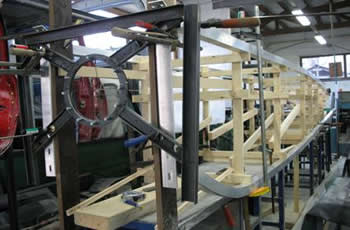
Under the expert guidance of teacher P. Lietaert we started with the construction of the aluminum aircraft body in our bodywork department.
Construction of the aluminum frame around a wooden skeleton
In the meantime Johan Vanbeselaere started a search for original drawings of the wings. Copies of these drawings came from a Finnish museum where a similar plane is displayed. Daniël Pauwels came to me with a strange question: "Geert could you make a wooden propeller for our plane? That's a bit like woodcarving, is not it? "He argued.
Schoolyear2007 – 2008Johan Vanbeselaere contacts Sašo Knez, physics teacher at the Trbovlje technical school in Slovenia. This school has the same type of engine but not the knowledge and drawings to repair it. Sašo Knez is also chairman of the Minima Historical Aircraft Club. This is a group of people who restore or completely rebuild old planes. He turned out to be the perfect person to teach us how to build the wings and how to upholster them. (www.aeroklub-minima.si)
That year the students of the Bodywork made the chassis, the superstructure and the steering system. Pupils from 1B help to make the wooden pilot seat.
The Brussels Army Museum lent us a wooden screw for two months to make measurements and counter profiles. However, there are some problems: their screw is 2.60 m long. This is 20 cm too long for us. Moreover, we have a left-handed engine, their propeller is right-handed. At the Poncelet company in Brussels, I get a very comprehensive explanation from the third generation of screwdrivers about the construction and the complete hand-working of a propeller. With Opendoor the plane was exhibited outside and the engine was tested. After a few attempts, it succeeds. The engine works.
Schoolyear 2008 – 2009:
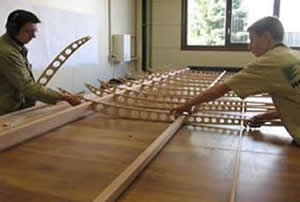
Thanks to the European Leonardo da Vinci project, it was possible for our and Slovenian students to decorate a subsidized foreign internship.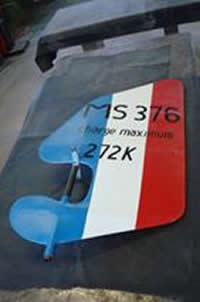
September 2008:
Six pupils and two teachers (Pol Lietaert and Geert Woussen) leave for Slovenia for two weeks under the watchful eye of coordinator Daniël Pauwels. There the students Autotechnieken Gilles Beeckman, Nick Borry and Wesley D'Hellem were instructed to disassemble and clean the parts of the engine. Warre Buysse, Lionel Knop and Wijnand Pauwelyn of the Wood department have made the metal rudder made in Ypres, fully covered with cloth. By making part of the wing they also learned how to make and connect the wooden parts. The rudder with the original marking. =>
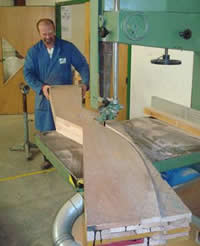
October 2008:
Under the guidance of colleagues Chris Horré and Frederik Maerten, pupils of 5HB make a first wooden wing construction of 5.50m long and 1.80m wide. Pupils from the Garage Department continue working on the onboard instruments.
<= Geert Woussen saws the wing profile from six layers of glued and shredded meranti planks.
November 2008:The VTI in turn receives a visit from seven pupils and two teachers from Slovenia. These people have covered the wing part made with polyester cloth. They also provide our first wing with the necessary metal fastening systems.
April 2009:
After some research we now know for certain that the machine gun is a Lewis MKIII.
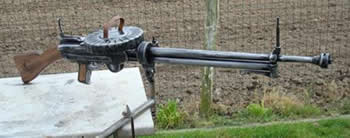
Through some internet forums we find an address of a person in Texas who has this type of machine gun before
a reasonable price in plastic. To approach the right model a lot of parts from beech wood have to be added.
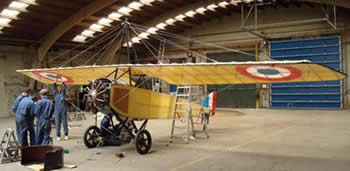
Visit also: Guynemer Paviljoen
